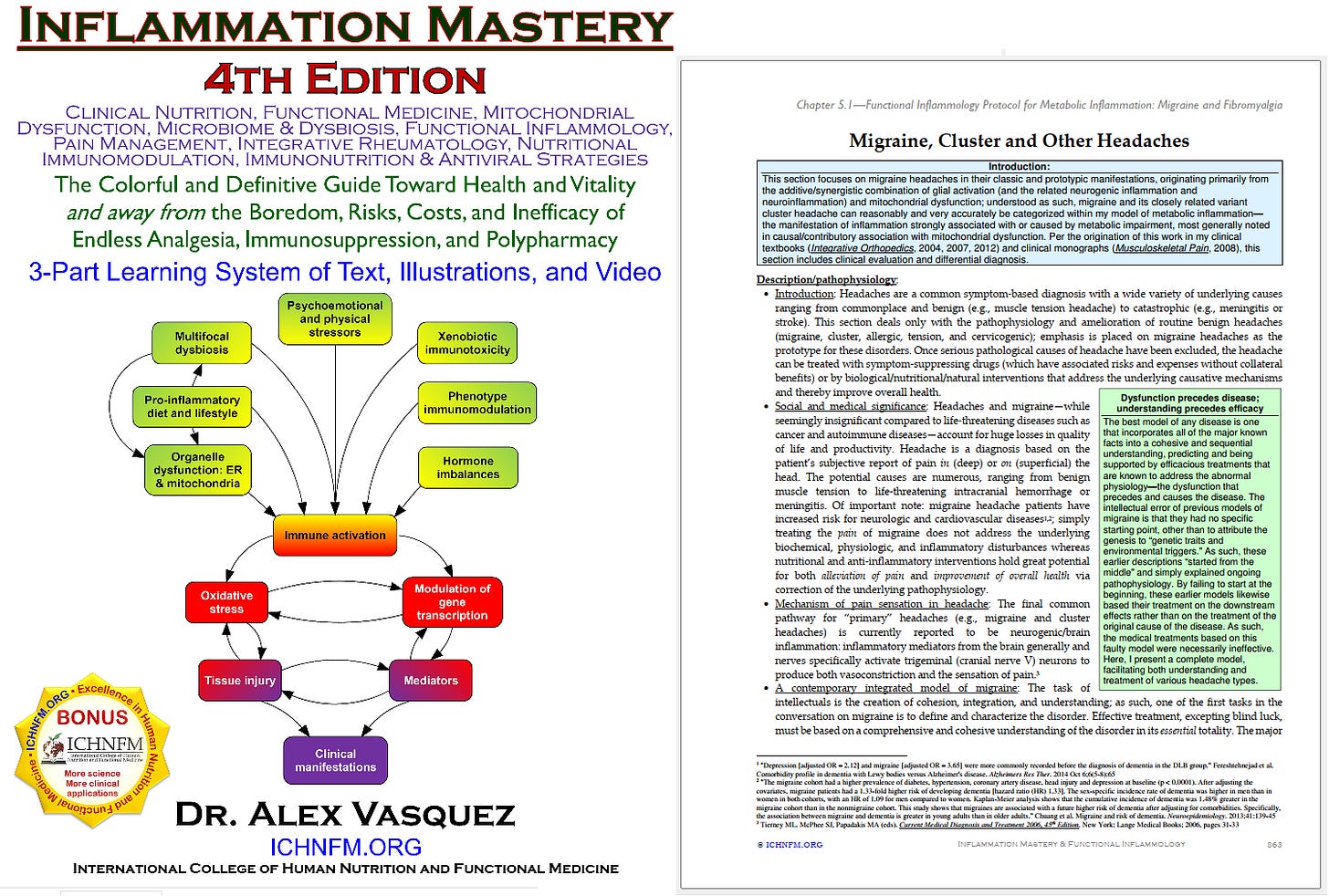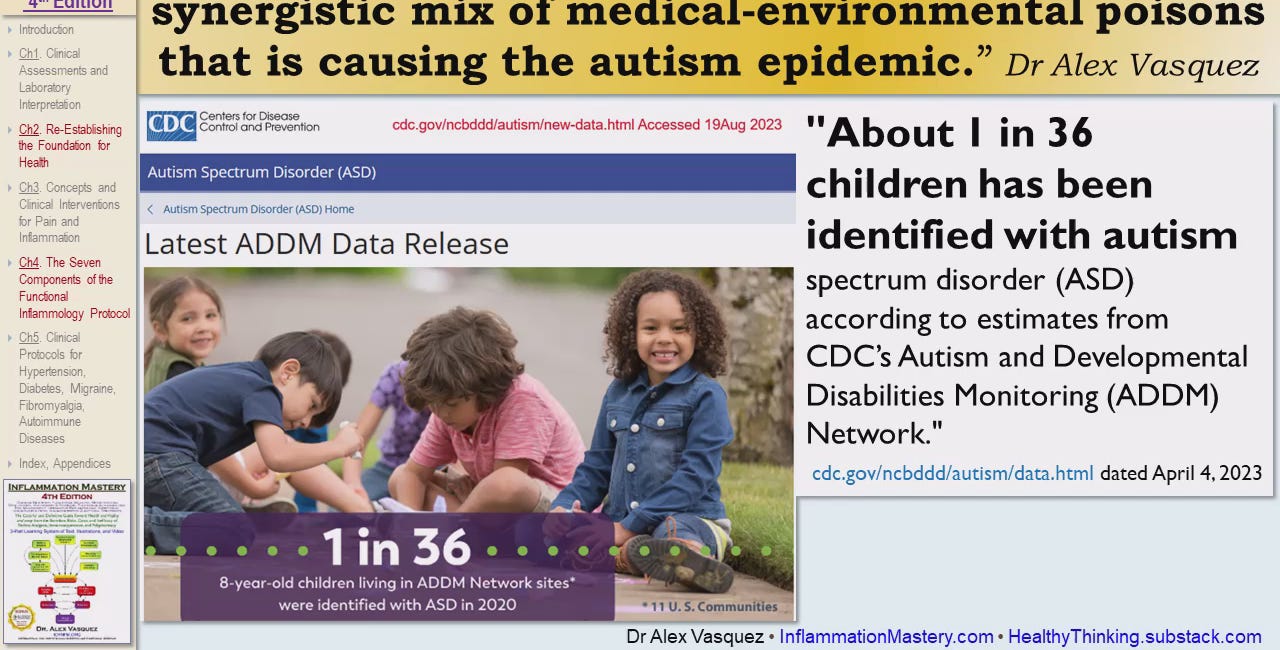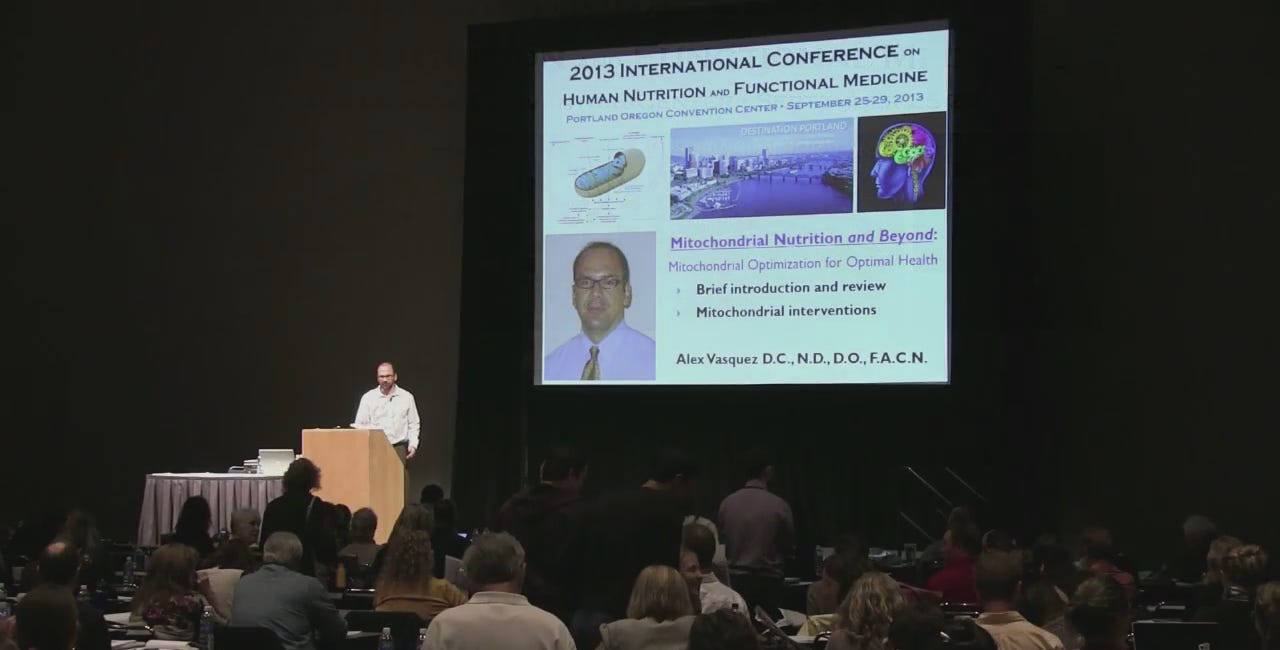Medical acknowledgement of population-wide neuro/mito-poisoning, followed by medical inaction and political silence
Note: This section is excerpted from the upcoming 5th Edition of my migraine protocol, which was most recently published in Inflammation Mastery 4th Edition (2016).
Note: This section is excerpted from the upcoming 5th Edition of my migraine protocol, which was most recently published in Inflammation Mastery 4th Edition (2016). I do not anticipate what I consider major changes in the protocol although obviously some new perspectives and interventions will be included. We are obviously at a time when we need a paradigm shift in the management of chronic pain conditions.
Medical-industrial acknowledgement of population-wide neuro/mito-poisoning, followed by medical inaction and political silence, because medicine and politics are funded by the same drug-chemical industry:
The medical-science professions publish the evidence demonstrating the causality and mechanisms by which “accrued toxic substances such as heavy metals, pesticides, plasticizers and other endocrine disrupting or neurotoxic compounds” can and do “disrupt normal brain physiology and to impair neurological homeostasis” leading directly to “headache, cognitive dysfunction, memory disturbance, and other neurological signs and symptoms, … subtle or overt alteration in thoughts, moods, or behaviors”[1] but then fail to take effective action, either in mandating limits to production of and exposure to these chemicals or in implementing clinical detoxification/depuration programs/protocols (reviewed in Chapter 4.7 of Inflammation Mastery 4th Edition).
The reason for this collusion between the drug and chemical industries is obvious: because they are essentially one and the same industry, including the production of disease-treating medicines (eg, the antiestrogen anticancer drug anastrazole/Arimidex) and disease-causing pesticides-plastics (eg, the xeno-estrogen procancer herbicide atrazine) from within the same company (eg, AstraZeneca and Novartis are the drug-making parent companies of pesticide-making Syngenta).[2] In its typical virtue-signaling lipservice followed by zero action, (Journal of the) American Medical Association published a “call to action”[3] in 2016 due to the yet-again-confirmed overwhelming evidence that chemical neurotoxins were directly contributing to the rise in prevalence of neurologic and “neurodevelopmental disorders” such as autism and attention-deficit disorder, which were previously rare/orphan diseases and are now epidemics (not less than 1 per 68 and 10% of children in 2016, respectively) in the United States:
“Citing an alarming increase in childhood neurodevelopmental disorders such as autism and attention-deficit/hyperactivity disorder (ADHD), a group of scientists, health professionals, and children’s health advocates is calling for increased monitoring, assessment, and reduction of neurotoxic chemicals. The Targeting Environmental Neuro-Developmental Risks (TENDR) Consensus Statement, published in July in Environmental Health Perspectives[4], is “a call to action to reduce exposures to toxic chemicals that can contribute to the prevalence of neurodevelopmental disabilities in America’s children.”
Autism is a sentinel—alarm and evidence of population-wide neuropoisoning and mitopoisoning:
The United States is painting the perfect picture of overexposure to neurotoxic pesticides correlating with an increased incidence of neurologic disorders, the sentinel disease of which is autism; the flagship neurotoxic insecticide is glyphosate which permeates American air/water/food and is a known mitochondrial poison especially in its polychemical commercial formulation sold as “Roundup.” The incidence of autism continues to steadily rise in the United States with every generation, from 1 per 150 in 2000, to 1 per 68 in 2010, to 1 per 36 in 2020, and 17% of American children have some type of formal/major/objective neurodevelopmental problem such as autism, attention-deficit/hyperactivity disorder, cortical blindness, or cerebral palsy.[5] Experimental research has repeatedly demonstrated that “exposure of glyphosate during pregnancy and lactation may cause [autism spectrum disorder] ASD-like behavioral abnormalities in male juvenile offspring”[6] and “maternal exposure to high levels of glyphosate causes ASD-like behavioral abnormalities and abnormal composition of gut microbiota in juvenile offspring”[7] which coincides with the observation that the air, rainwater, and food supply of the United States is saturated with pesticides generally and glyphosate in particular: “Atrazine, metolachlor, and propanil were detected in ≥50% of the air and rain samples in both years. Glyphosate and its degradation product, aminomethyl-phosphonic acid (AMPA), were detected in ≥75% of air and rain samples in 2007…”[8] Per British Medical Journal 2019, risk of autism increases with prenatal exposure to “glyphosate (odds ratio 1.16), chlorpyrifos (1.13), diazinon (1.11), malathion (1.11), avermectin (1.12), and permethrin (1.10). For autism spectrum disorder with intellectual disability, estimated odds ratios were higher (by about 30%) for prenatal exposure to glyphosate (1.33), chlorpyrifos (1.27), diazinon (1.41), permethrin (1.46), methyl bromide (1.33), and myclobutanil (1.32); exposure in the first year of life increased the odds for the disorder with comorbid intellectual disability by up to 50% for some pesticide substances.”[9]
Most neurotoxic pesticides—exemplified by glyphosate-based herbicides—are mitochondrial poisons, causing MitoDysfxn:
Per experimental research, glyphosate-based herbicides (GBH) cause neurotoxic effects including reduced cell viability and behavioral impairments caused partly or mostly by mitochondrial dysfunction including “inhibited mitochondrial complex enzymatic activity, modulated gene expression related to mitochondrial complexes, induced an increase in RS [reactive species, ie, free radicals, ROS] production, promoted hyperpolarization of mitochondrial membrane.”[10] The combination of the herbicide glyphosate (the poison) with the surfactant TN20 (disrupts barrier to allow entry into the cell) is—as expected—much more dangerous than either chemical in isolation, leading to MitoDysfxn, such that “Caspase activity increased and mitochondrial membrane potential decreased [indicating mitochondrial failure] only when the cells were exposed to a mixture of both TN-20 and glyphosate, but not after exposure to either one of these compounds. The results support the possibility that mixtures of glyphosate and TN-20 aggravate mitochondrial damage and induce apoptosis and necrosis. Throughout this process, TN-20 seems to disrupt the integrity of the cellular barrier to glyphosate uptake, promoting glyphosate-mediated toxicity.”[11] Those results in 2013 had been foreshadowed in 2005 by research effectively showing that 1) the GBH formulation was worse than G in isolation, and that 2) mechanisms of GBH toxicity included direct impact on mitochondrial function, including mitochondrial swelling due to permeability defects and “partial inhibition of mitochondrial complexes 2 and 3.”[12] All of this was predicted not later than 1979, when researchers found that induction of mitochondrial dysfunction appeared to be the major mechanism of action of glyphosate toxicity, ie, “…uncoupling of mitochondrial oxidative phosphorylation may be a major lesion in glyphosate intoxication.”[13]
Everyone is poisoned by corporate chemicals, but the manifestations are dependent on variables such as age of exposure, duration and intensity of exposure, genetic predispositions (eg, to mitochondrial impairment, detoxification abilities), totality of xenobiotic load (ie, “total load” per Crinnion), totality/combinations of xenobiotics plus adipose-hormones plus “total microbial load” (TML) to produce the “total inflammatory load” (TIL) per Vasquez, diet and nutritional status, etc:
The important insight that I had when reviewing this data in 2023 was that all of us—everyone in overpolluted countries such as the United States—is being exposed to this same neurotoxic chemical cocktail, and the rising incidence of autism is only the proverbial tip-of-the-iceberg and surrogate marker for population-wide exposure/accumulation of persistent organic pollutants (POPs) that contribute to neuropathology (including Parkinson’s disease) and (other) metabolic-mitochondrial disorders such as fatty liver disease, obesity, diabetes mellitus. Obviously, the ever-increasing incidence of autism is a barometer showing us that the environment is overloaded with chemical neurotoxins, which combine to form what I call the “autism cocktail.” However, this same chemical-drug combination can have other clinical-pathologic consequences and manifestations depending on its combination with other variables; in other words: “We are all being exposed to the same environmental-medical cocktail, but everyone has different manifestations per age, gender, other diseases and drug-injection exposures.” See https://healthythinking.substack.com/p/americas-autism-cocktail-performing for my initial spontaneous realization. See my video presentation on mitochondrial dysfunction.
America's AUTISM COCKTAIL performing perfectly to increase Autism to 1-per-36 along with other manifestations per demographics and co-exposures
SEE NEW SPONTANEOUS VIDEO ABOVE “About 1 in 36 children has been identified with autism spectrum disorder (ASD) according to estimates from CDC’s Autism and Developmental Disabilities Monitoring (ADDM) Network.” Infographic with children (below) sourced from CDC
Note: This section is excerpted from the upcoming 5th Edition of my migraine protocol, which was most recently published in Inflammation Mastery 4th Edition (2016). I do not anticipate what I consider major changes in the protocol although obviously some new perspectives and interventions will be included. We are obviously at a time when we need a paradigm shift in the management of chronic pain conditions.
Vasquez, Mitochondrial Nutrition ICHNFM2013 Presentation
Note: This section is excerpted from the upcoming 5th Edition of my migraine protocol, which was most recently published in Inflammation Mastery 4th Edition (2016). I do not anticipate what I consider major changes in the protocol although obviously some new perspectives and interventions will be included.






